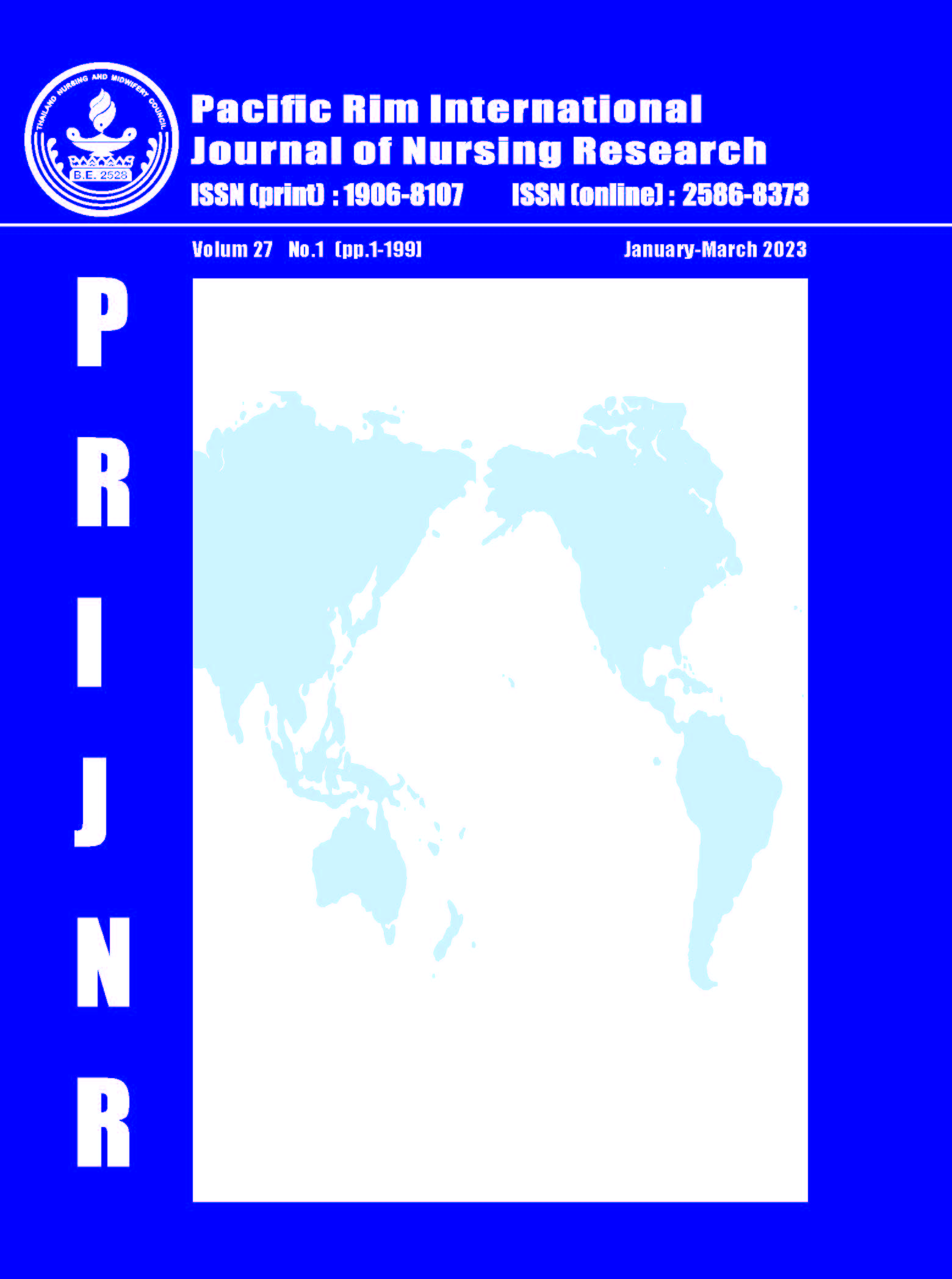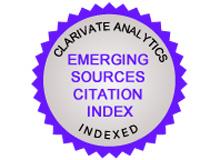A Model of Factors Influencing Health-Related Quality of Life among Thais with Colorectal Cancer and a Permanent Colostomy
DOI:
https://doi.org/10.60099/prijnr.2023.260341Keywords:
Causal model, Colorectal cancer, Health-related quality of life, Model testing, Permanent colostomy, ThailandAbstract
Enhancing health-related quality of life among colorectal cancer survivors with a colostomy has become a significant concern for healthcare professionals. An understanding of factors involved in this condition and treatment, and how these work to affect the health-related quality of life of cancer survivors is a foundation for developing effective interventions. This cross-sectional study aimed to develop and test a health-related quality of life model among people with colorectal cancer and a permanent colostomy. Data were collected from 232 Thais with colorectal cancer and a permanent colostomy from six tertiary hospitals in southern Thailand by using seven instruments, including the Demographic and Health-related Data Form, the Social Support Questionnaire, the Bowel Function Inventory-Colorectal Surgery, the Center for Epidemiologic Studies Depression Scale, the Body Image Scale, the Chula ADL Index, and the Quality of Life Index-Cancer version III. Descriptive statistics and structural equation modeling were used for analyzing the data.
The results indicated that the final model fitted with the empirical data and explained 72% of the variance in health-related quality of life. Three factors, carcinoembryonic antigen, gender, and age, had an indirect effect on health-related quality of life through different paths. Six factors, religion, social support, bowel symptoms, depressive symptoms, body image disturbance, and functional status, had both direct and indirect effects on health-related quality of life, with body image disturbance being the strongest effect. Nurses and other health professionals can use the findings of this study to design a comprehensive intervention to improve the quality of life for this group of patients. Such an intervention needs to target all the factors of this study, especially improving body image, functional status, and social support, and managing bowel and depressive symptoms. This intervention should be further tested in clinical practice.
References
Sung H, Ferlay J, Siegel RL, Laversanne M, Soerjomataram I, Jemal A, et al. Global cancer statistics 2020: GLOBOCAN estimates of incidence and mortality worldwide for 36 cancers in 185 countries. CA Cancer J Clin. 2021;71(3):209-49. doi: 10.3322/caac.21660.
International Agency for Research on Cancer, World Health Organization. Summary statistics 2020 [Internet]; 2021 [cited 2022 Nov 25]. Available from: https://gco.iarc.fr/today/data/factsheets/populations/764-thailand-fact-sheets.pdf
National Cancer Institute of Thailand. Hospital-based cancer registry 2021. In: Cancer Registry Unit ITD, National Cancer Institute, editor [Internet]. Bangkok (TH): New Thammada Press; 2022 [cited 2022 Nov 25]. Available from: https://nci.go.th/e_book/hosbased_2564/index.html
Lohsiriwat V, Chaisomboon N, Pattana-Arun J. Current colorectal cancer in Thailand. Ann Coloproctol. 2020;36(2): 78-82. doi:10.3393/ac.2020.01.07.
Virani S, Bilheem S, Chansaard W, Chitapanarux I, Daoprasert K, Khuanchana S, et al. National and subnational population-based incidence of cancer in Thailand: assessing cancers with the highest burdens. Cancers. 2017;9(8):108. doi: 10.3390/cancers9080108.
Ratchasan P, Monkong S, Aree-Ue S. Selected factors related to adaptation among colorectal cancer older adults with a colostomy. BKK Med J [Internet]. 2020 [cited 2021 Jun 18];16(1):50-7. Available from: https://he02.tcithaijo.org/index.php/bkkmedj/ article/view/239979
Kunnavuttivanich V, Pramyothin P, Ithimakin S. Association between dietary patterns and disease recurrence in Thai colorectal cancer patients. Medicine. 2020;99:11(e19522). doi:10.1097/MD.0000000000019522.
Garcia-Henriquez N, Galante DJ, Monson JR. Selection and outcomes in abdominoperineal resection. Front Oncol. 2020;10:1339. doi: 10.3389/fonc.2020.01339.
Sandberg S, Asplund D, Bock D, Ehrencrona C, Ohlsson B, Park J, et al. Predicting life with a permanent end colostomy: a prospective study on function, bother and acceptance. Colorectal Dis. 2021;23(10):2681-9. doi: 10.1111/codi.15842.
Alwi F. Quality of life of persons with permanent colostomy: a phenomenological study. J Coloproctol. 2018;38(4): 295-301. doi: 10.1016/j.jcol.2018.06.001.
Alenezi A, Livesay K, McGrath I, Kimpton A. Ostomy‐related problems and their impact on quality of life of Saudi ostomate patients: a mixed‐methods study. J Clin Nurs. 2022;00:1-13. doi: 10.1111/jocn.16466.
Diniz IV, Costa IKF, Nascimento JA, Silva IPd, Mendonça AEOd, Soares MJGO. Factors associated to quality of life in people with intestinal stomas. Rev Esc Enferm USP. 2021; 55:1-8. doi: 10.1590/1980-220X-REEUSP-2020-0377.
Plazibat V, Prlić N, Kovačević A. The quality of life of a patient with colostomy. SEEMED J [Internet]. 2017 [cited 2021 Jun 18];1(2):81-9. Available from: https://hrcak.srce.hr/205898
Duffy MJ. Carcinoembryonic antigen as a marker for colorectal cancer: is it clinically useful? Clin Chem [Internet]. 2001 [cited 2021 Jun 18];47(4):624-30. Available from: https://www.researchgate.net/profile/Michael-Duffy-11/publication/12059152_Carcinoembryonic_Antigen_as_a_Marker_for_Colorectal_Cancer_Is_It_Clinically_Useful/links/0c96052789b8cf3409000000/Carcinoembryonic-Antigen-as-a-Marker-for-Colorectal-Cancer-Is-It-Clinically-Useful.pdf
Leyk M, Ksiazek J, Habel A, Dobosz M, Kruk A, Terech S. The influence of social support from the family on health related-quality of life in persons with a colostomy. J Wound Ostomy Continence Nurs. 2014;41(6):581-8. doi: 10.1097/WON.0000000000000086.
Nam KH, Kim HY, Kim JH, Kang K, Na SY, Han BK. Effects of social support and self-efficacy on the psychosocial adjustment of Korean ostomy patients. Int Wound J. 2019; 16(Suppl 1):13-20. doi: 10.1111/iwj.13038.
Wuletaw CZ, Tilahun D, Yisihak S, Berhanetsehay T. Quality of life in patients living with stoma. Ethiop J Health Sci. [Internet]. 2021 [cited 2022 Oct 27];31(5):993-1000. Available from: https://www.ajol.info/index.php/ejhs/article/download/215805/203512
Ketterer SN, Leach MJ, Fraser C. Factors associated with quality of life among people living with a stoma in nonmetropolitan areas. Nurs Res. 2021;70(4):281-8. doi:10.1097/NNR.0000000000000511.
Laghousi D, Jafari E, Nikbakht H, Nasiri B, Shamshirgaran M, Aminisani N. Gender differences in health-related quality of life among patients with colorectal cancer. J Gastrointest Oncol. 2019;10(3):453-61. doi: 10.21037/jgo.2019.02.04.
Ferrans CE, Zerwic JJ, Wilbur JE, Larson JL. Conceptual model of health-related quality of life. J Nurs Scholarsh. 2005;37(4):336-42. doi: 10.1111/j.1547-5069. 2005.00058.x.
Gulhati P, Yin J, Pederson L, Schmoll H-J, Hoff P, Douillard J-Y, et al. Threshold change in CEA as a predictor of non-progression to first-line systemic therapy in metastatic colorectal cancer patients with elevated CEA. J Natl Cancer Inst. 2020;112(11):1127-36. doi:10.1093/jnci/djaa020.
Meecharoen W, Sirapo-ngam Y, Monkong S, Oratai P, Northouse LL. Factors influencing quality of life among family caregivers of patients with advanced cancer: a causal model. Pacific Rim Int J Nurs Res [Internet]. 2013 [cited 2020 Jun 18];17(4):304-16. Available from: https://he02.tci-thaijo.org/index.php/PRIJNR/article/view/9535
Gautam S, Koirala S, Poudel A, Paudel D. Psychosocial adjustment among patients with ostomy: a survey in stoma clinics, Nepal. Nurs Res Rev. 2016;6:13-21. doi: 10.2147/NRR.S112614.
Phamornpon S. Quality of life in patients with permanent colostomies: a challenge to nursing roles. Thai J Nurs Council [Internet]. 2018 [cited 2021 Feb 22];33(4):19-32. Available from: https://he02.tci-thaijo.org/index.php/TJONC/article/view/118763 (in Thai)
Dung PT, Lan NTP, Khanh PKP, Chinh ND. Quality of life of patients with permanent colostomy after the Miles operation for low rectal cancer at Vietnam National Cancer Hospital, Hanoi. Thai J Surg [Internet]. 2021 [cited 2022 Oct 29];42(2):49-53. Available from: https://he02.tci-thaijo.org/index.php/ThaiJSurg/article/view/246631
Deng L, Yang M, Marcoulides KM. Structural equation modeling with many variables: a systematic review of issues and developments. Front Psychol. 2018;9:1-14. doi: 10.3389/fpsyg.2018.00580.
Soper DS. Structural Equation Model Sample Size Calculator [Online Software]. 2022 [cited 2022 Nov 12]. Available from: https://www.danielsoper.com/statcalc/calculator.aspx?id=89
Colina S, Marrone N, Ingram M, Sánchez D. Translation quality assessment in health research: a functionalist alternative to back-translation. Eval Health Prof. 2017;40(3):267-93. doi: 10.1177/0163278716648191.
O’Sullivan M. Bowel symptom management following sphincter-sparing surgery for rectal cancer [master’s thesis]. [Ireland]: University College Cork; 2019 [cited 2022 Nov 12]. Available from: https://hdl.handle.net/10468/9985
Nilmanut S, Kuptniratsaikul V, Pekuman P, Tosayanonda O. The study of the Center for Epidemiologic Studies-Depression Scale (CES-D) in Thai people in Siriraj hospital. J Rehabil Med [Internet]. 1997 [cited 2021 Feb 22];6(3):25-9. Available from: https://www.rehabmed.or.th/main/wp-content/uploads/2015/01/L-80.pdf (in Thai)
Hopwood P, Fletcher I, Lee A, Al Ghazal S. A body image scale for use with cancer patients. Eur J Cancer. 2001;37(2): 189-97. doi: 10.1016/s0959-8049(00)00353-1.
Songtish D, Hirunwiwatkul P. Development and validation of the body image scale among Thai breast cancer patients. J Med Assoc Thai [Internet]. 2013 [cited 2020 Jun 18];96:S30-9. Available from: http://www.jmatonline.com/index.php/jmat/article/view/2470
Jitapunkul S, Kamolratanakul P, Ebrahim S. The meaning of activities of daily living in a Thai elderly population: development of a new index. Age Ageing. 1994;23(2):97-101. doi: 10.1093/ageing/23.2.97.
Hanucharurnkul S. Social support, self-care, and quality of life in cancer patients receiving radiotherapy in Thailand [dissertation]. [Detroit (MI)]: Wayne State University; 1988 [cited 2022 Nov 12]. Available from: https://www.proquest.com/openview/92a9616153a763c0f5c2edc369909a3c/1?pq-origsite=gscholar&cbl=18750&diss=y
Kaveevivitchai C, Hanucharurnkul S, Kanjanapanjapol S. Relationships among selected factors, uncertainty in illness, social support and adaptation in breast cancer women receiving chemotherapy [Master’s thesis]. [Bangkok (TH)]: Mahidol University; 1993.
Ferrans CE, Powers MJ. Quality of life index: development and psychometric properties. ANS Adv Nurs Sci. 1985; 8(1): 15-24. doi: 10.1097/00012272-198510000-00005.
Nuchniyom C. The development on quality of life by Buddhist integration. JMPS J of MCU Peace Studies [Internet]. 2018 [cited 2021 Mar 16];6(2):619-31. Available from: https://so03.tci-thaijo.org/index.php/journal-peace/article/view/101182 (in Thai)
de Campos K, Bot LHB, Petroianu A, Rebelo PA, de Souza AAC, Panhoca I. The impact of colostomy on the patient’s life. J Coloproctology [Internet]. 2017 [cited 2022 Oct 27];37(3):205-10. Available from: https://www.scielo.br/j/jcol/a/qtMSBG5TszWMxYfTRvMFqwh/?lang=en
Downloads
Published
How to Cite
Issue
Section
License
Copyright (c) 2022 Pacific Rim International Journal of Nursing Research

This work is licensed under a Creative Commons Attribution-NonCommercial-NoDerivatives 4.0 International License.
Copyright: The Pacific Rim International Journal of Nursing Research, Thailand Nursing & Midwifery Council has exclusive rights to publish, reproduce and distribute the manuscript and all contents therein.








.png)



